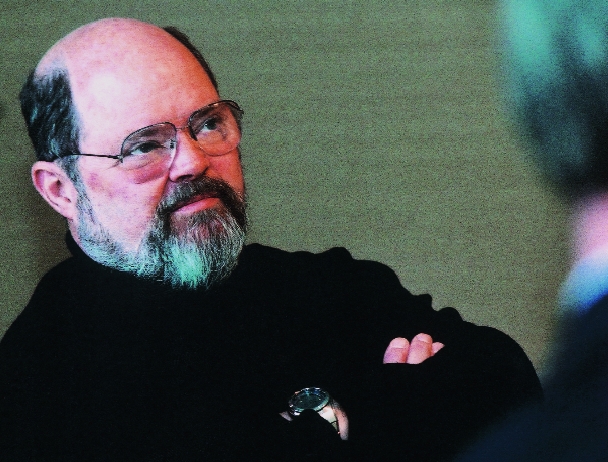A Blizzard of Learning
Highlights from the 2003 IDEA Personal Trainer International Summit®

What a weekend to remember.
Apparently, the 1,300 delegates, exhibitors, presenters, IDEA assistants and staff who attended the 2003 IDEA Personal Trainer International Summit® took its theme of “Putting Fitness First–Elevating the Fitness Priority” literally. Considering the snowy circumstances, the turnout might have lacked luster. Instead, PFTs from 14 countries traveled to Washington, D.C., and learned from inspired presenters and a program bursting with creative and practical possibilities.
Hear Today, Use Tomorrow
This year’s program introduced some unique sessions, five of which directly related to IDEA’s Inspire the World to Fitness™ initiative. All these sessions provided practical information that attendees could try immediately with their clients.
- The summit began with a panel discussion (detailed in “Confronting the Obesity Epidemic,” page 28), which opened the floor to delegates’ questions and gave a glimpse of the tough but sure-to-be-satisfying challenges awaiting PFT activists in the battle against obesity and inactivity.
- In “Leading the Inactive Client to Your Door,” Nicki Anderson provided insight into why overweight and obese clients believe that exercise will not help them reach their goals and is only for “skinny” people. Anderson’s interactive format opened discussion on knowing your market. She offered tips not only on where to find potential clients but also on how to approach and interview them, deliver the services they want and construct effective questionnaires.
- John Jakicic, PhD, researcher and educator at the University of Pittsburgh Physical Activity and Weight Management Research Center, presented two sessions that focused on the behavioral aspects of successful weight loss and exercise. In “New Research on Obesity and the Exercise Link,” he shared his own recent study (under review for publication in the Journal of the American Medical Association), saying that selling “just exercise” to clients is not enough. “I think we sometimes sell the wrong package to people early on when we just sell exercise,” he said. “We also need to point clients in the right direction to nutrition professionals who can create with us a program that combines sensible eating with the exercise.”
- In “Strength Training for Overweight and Underfit Kids,” Wayne Westcott, PhD, presented convincing evidence that preadolescents who participate in sensible resistance exercise can safely increase their muscle strength and mass, decrease their body fat, increase their bone mineral density, improve their functional capacity and reduce their risk of injury. He also addressed common concerns regarding youth strength training and provided several teaching aids for ensuring safe and successful progression for young clients: Define clear objectives, share encouragement, give concise instructions, do one task at a time, supervise attentively, give appropriate and specific feedback, provide positive reinforcement, answer questions carefully and progress kids gradually.
In his second session, “Weight Management and Relapse Prevention,” Jakicic explored strategies that research subjects found effective for keeping weight off once it’s been shed. Jakicic shared these keys to client relapse prevention: setting sensible, measurable, attainable, responsible and time-oriented (S.M.A.R.T.) goals; practicing self-monitoring and getting feedback; getting social support and maintaining healthy contact; controlling environmental stimuli; and identifying, defining and predicting high-risk situations in which maintaining behavior change may be difficult.
Other Highlights
- The Fitness Expo featured more than 100 booths. On exhibit were resistance training and Pilates equipment and accessories, fitness apparel, training tools, nutrition and hydration products, books, videos and music. Representatives from certifying and continuing-education bodies were also on hand.
- Three appealing presummit offerings drew many trainers into D.C. a day early:
- In “STOTT PILATES™ Dynamic Sports Conditioning,” Moira Stott-Merrithew linked fundamental Pilates exercises with the dynamic surface of the BOSU® Balance Trainer. PFTs learned a wide range of movements in various positions, including supine, prone, sitting, kneeling, lunging, standing and jumping. In 3 hours, Stott-Merrithew’s creative moves inspired trainers to introduce clients to fun and varied workouts while stepping up the level of neuromuscular challenge.
- Greg Roskopf, MA, taught a 7-hour course on “Muscle Activation Techniques for the Lower Body.” The course introduced Roskopf’s method of evaluating and correcting muscular imbalances that contribute to chronic pain or injury. Attendees learned to approach clients’ pain systematically, evaluate range of motion effectively and conduct isolated muscle strength testing.
- Gary Gray, PT, a leading pioneer and authority on rehabilitation and training, led a 6-hour course entitled “Functional Thresholds, Assessments and Program Design.” Gray covered the application of practical and consistent testing tools used to measure and assess all components of function.
- Juan Carlos Santana, MEd, brought his intensely enthusiastic and entertaining presentation style back to the Summit, delivering four courses in all: “Advanced Concepts in Ball Training,” “BRAAD for Improved Performance,” “Speed and Power Training for Active Seniors” and “Body Weight Training: The Forgotten Workout.” “I never say ‘don’t’ or ‘no’ to my clients,” Santana shared. “Your cuing always needs to be positive.”
- Back by popular demand, the Lifestyle Coaching Track attracted PFTs looking for an alternative revenue stream or variety in their businesses. With faculty members Beth Rothenberg, Kate Larsen, Susan Cantwell and Gail Parmer leading the curriculum, trainers were progressed along, with each class building on the one before.
- Presented by the National Academy of Sports Medicine, the Personal Trainer Fundamentals Track provided a foundation of knowledge in anatomy and kinesiology, exercise technique, program design and business techniques.
- Several new presenters debuted on the Summit program this year:
- In “Professional and Profitable In-Home Training,” Kay Cross, MEd, shared her successful tricks of the trade, making several salient business points. She emphasized that PFTs should have exceptionally high standards for every piece of paper and other marketing item on which their names or logos appear. She said that this is often the only chance a trainer has to get the attention of a potential client. “Ask yourself whether or not you’d be happy to have the president of the United States see your business forms or letterhead. That’s how good I think they need to look,” she told attendees.
- Sue Hitzmann, MS, owner of Body Language™ Fitness Company, captivated her attendees in “The Body S.Q.U.A.R.E.” Hitzmann’s Body Language method teaches clients how to balance the functions of the entire body, beginning with basic awareness and understanding of movement potential, postural alignment and core stability. “If you’re going to change a client’s structure, you need to change either his environment or his adaptability to it,” she told engrossed attendees.
- Biomechanics expert Mel Siff, PhD, delighted attendees with his high-energy and humor-charged teaching style. Pratfalls and other physical comedy techniques helped him drive home his message about the facts and fallacies of core, balance and functional training methods. “My goal this session is to have you leave here questioning theories about function and questioning yourself all the time. Try to understand why you do these things,” he urged a packed room of PFTs.
- In his courses “Training Clients With Neuromuscular Disorders” and “Help Your Clients Regain Function,” 2002 IDEA Personal Trainer of the Year Taylor-Kevin Isaacs, MS, introduced an actual teenage client of his. Attendees learned the story of the teen’s postrehab success after a motorcycle accident nearly left him paralyzed. Isaacs’s refreshing hands-on approach and engaging teaching style held delegates’ strong attention through the sometimes technical subject matter.
- J.P. Montalvan, MBA, MS, shared his considerable PFT business acumen in sessions about growing one’s clientele base and capitalizing on fitness trends. He seasoned his talks with philosophical observations that PFTs can apply in planning their businesses and fine-tuning their strategies. “Needs are states of felt deprivation. Wants are shaped by culture and individual personality. Your clients need to be healthy. You want them to be fit,” he said.
See You in New York
in October 2004!
Snow notwithstanding, if you attended this event, you truly are a part of IDEA history. This was the last Summit to be held at this time of year. Because many of you have told us in recent years how busy February and March are for you, we’ve moved the IDEA Personal Trainer International Summit® to autumn. Next year, it will be in October in Manhattan; visit IDEA’s Web site (www.IDEAfit.com) for updated information.
Meanwhile, we have lined up more great education for the remainder of this year. The IDEA Personal Trainer Congress® is scheduled for April 24 in Rosemont, Illinois, a Chicago suburb. The 2003 IDEA World Fitness and Personal Trainer Convention® is slated for July 17 to 20 in Anaheim, California, with preconvention offerings on July 16. If you need information on either of these upcoming events, please contact IDEA member services at (800) 999-4332 or (858) 535-8979, ext. 7.
Sandy Todd Webster
For 22 years, Sandy Todd Webster was the chief architect of IDEA's content program - including the award-winning IDEA FITNESS JOURNAL and IDEA FOOD & NUTRITION TIPS - the industry's leading resources for fitness, wellness and nutrition professionals worldwide. She created, launched and nurtured these brands and many others during her productive and purposeful IDEA tenure. Sandy is a Rouxbe-certified professional plant-based cook and a Precision Nutrition Level 1 Coach who is pursuing a Master's degree in Sustainable Food Systems through The Culinary Institute of America (expected August 2024). She plans to combine these passions with her content expertise to continue inspiring others to make the world a more just, healthy and regenerative place.






